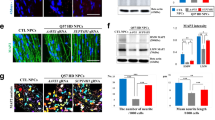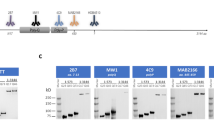Abstract
By crossing Huntington's disease (HD) R6/1 transgenic mice with ‘tissue’ transglutaminase (TG2) knock-out mice, we have demonstrated that this multifunctional enzyme plays an important role in the neuronal death characterising this disorder in vivo. In fact, a large reduction in cell death is observed in R6/1, TG2−/− compared with R6/1 transgenic mice. In addition, we have shown that the formation of neuronal intranuclear inclusions (NII) is potentiated in absence of the ‘tissue’ transglutaminase. These phenomena are paralleled by a significant improvement both in motor performances and survival of R6/1, TG2−/− versus R6/1 mice. Taken together these findings suggest an important role for tissue transglutaminase in the regulation of neuronal cell death occurring in Huntington's disease.
Similar content being viewed by others
Log in or create a free account to read this content
Gain free access to this article, as well as selected content from this journal and more on nature.com
or
Abbreviations
- HD:
-
Huntington's disease
- NII:
-
neuronal intranuclear inclusions
- TG2:
-
type 2 transglutaminase
- htt:
-
huntingtin
- ANOVA:
-
analysis of variance between groups
References
Melino G, Piacentini M . 1998 ‘Tissue’ transglutaminase in cell death: a downstream or a multifunctional upstream effector? FEBS Lett. 430: 59–63
Piacentini M, Colizzi V . 1999 Tissue transglutaminase: apoptosis versus autoimmunity Immunol. Today 20: 130–134
Gentile V, Thomazy V, Piacentini M, Fesus L, Davies PJ . 1992 Expression of tissue transglutaminase in Balb-C 3T3 fibroblasts: effects on cellular morphology and adhesion J. Cell Biol. 119: 463–474
Oliverio S, Amendola A, Rodolfo C, Spinedi A, Piacentini M . 1999 Inhibition of ‘tissue’ transglutaminase increases cell survival by preventing apoptosis J. Biol. Chem. 274: 34123–34128
Melino G, Annicchiarico-Petruzzelli M, Piredda L, Candi E, Gentile V, Davies PJ, Piacentini M . 1994 Tissue transglutaminase and apoptosis: sense and antisense transfection studies with human neuroblastoma cells Mol. Cell. Biol. 14: 6584–6596
Nakaoka H, Perez DM, Baek KJ, Das T, Husain A, Misono K, Im MJ, Graham RM . 1994 Gh: a GTP-binding protein with transglutaminase activity and receptor signaling function Science 264: 1593–1596
The Huntington's Disease Collaborative Research Group. 1993 A novel gene containing a trinucleotide repeat that is expanded and unstable on Huntington's disease chromosomes Cell 72: 971–983
DiFiglia M, Sapp E, Chase KO, Davies SW, Bates GP, Vonsattel JP, Aronin N . 1997 Aggregation of huntingtin in neuronal intranuclear inclusions and dystrophic neurites in brain Science 277: 1990–1993
Perutz MF, Johnson T, Suzuki M, Finch JT . 1994 Glutamine repeats as polar zippers: their possible role in inherited neurodegenerative diseases Proc. Natl. Acad. Sci. USA 91: 5355–5358
Kahlem P, Green H, Djian P . 1998 Transglutaminase action imitates Huntington's disease: selective polymerization of Huntingtin containing expanded polyglutamine Mol. Cell 1: 595–601
Chun W, Lesort M, Tucholski J, Ross CA, Johnson GV . 2001 Tissue transglutaminase does not contribute to the formation of mutant huntingtin aggregates J. Cell Biol. 153: 25–34
Mangiarini L, Sathasivam K, Seller M, Cozens B, Harper B, Hetherington C, Lawton M, Trottier Y, Lehrach H Davies SW, Bates GP . 1996 Exon 1 of the HD gene with an expanded CAG repeat is sufficient to cause a progressive neurological phenotype in transgenic mice Cell 87: 493–506
De Laurenzi V, Melino G . 2001 Gene disruption of tissue transglutaminase Mol. Cell. Biol. 21: 148–155
Tarcsa E, Fesus L . 1990 Determination of epsilon (gamma-glutamyl)lysine crosslink in proteins using phenylisothiocyanate derivatization and high-pressure liquid chromatographic separation Anal. Biochem. 186: 135–140
Karpuj MV, Garren H, Slunt H, Price DL, Gusella J, Becher MW, Steinman L . 1999 Transglutaminase aggregates huntingtin into nonamyloidogenic polymers, and its enzymatic activity increases in Huntington's disease brain nuclei Proc. Natl. Acad. Sci. USA 96: 7388–7393
Jeitner TM, Bogdanov MB, Matson WR, Daikhin Y, Yudkoff M, Folk J E, Steinman L, Browne SE, Beal M F, Blass J P, Cooper A J . 2001 N(epsilon)-(gamma-L-glutamyl)-L-lysine (GGEL) is increased in cerebrospinal fluid of patients with Huntington's disease J. Neurochem. 79: 1109–1112
Saudou F, Finkbeiner S, Devys D, Greenberg ME . 1998 Huntingtin acts in the nucleus to induce apoptosis but death does not correlate with the formation of intranuclear inclusions Cell 95: 55–66
Simeoni S, Mancini MA, Stenoien DL, Marcelli M, Weigel NL, Zanisi M, Martini L, Poletti A . 2000 Motoneuronal cell death is not correlated with aggregate formation of androgen receptors containing an elongated polyglutamine tract Hum. Mol. Genet. 9: 133–144
Akimov SS, Krylov D, Fleischman LF, Belkin AM . 2000 Tissue transglutaminase is an integrin-binding adhesion coreceptor for fibronectin J. Cell Biol. 148: 825–838
Turmaine M, Raza A, Mahal A, Mangiarini L, Bates GP, Davies SW . 2000 Nonapoptotic neurodegeneration in a transgenic mouse model of Huntington's disease Proc. Natl. Acad. Sci. USA 97: 8093–8097
Iannicola C, Moreno S, Oliverio S, Nardacci R, Ciofi-Luzzatto A, Piacentini M . 2000 Early alterations in gene expression and cell morphology in a mouse model of Huntington's disease J. Neurochem. 75: 830–839
Kegel KB, Kim M, Sapp E, McIntyre C, Castano JG, Aronin N, DiFiglia M . 2000 Huntingtin expression stimulates endosomal-lysosomal activity, endosome tubulation, and autophagy J. Neurosci. 20: 7268–7278
Kiyama H, Seto-Ohshima A, Emson PC . 1990 Calbindin D28K as a marker for the degeneration of the striatonigral pathway in Huntington's disease Brain Res. 525: 209–214
Luesse HG, Schiefer J, Spruenken A, Puls C, Block F, Kosinski CM . 2001 Evaluation of R6/2 HD transgenic mice for therapeutic studies in Huntington's disease: behavioral testing and impact of diabetes mellitus Behav. Brain Res. 126: 185–195
Karpuj MV, Becher MW, Springer JE, Chabas D, Youssef S, Pedotti R, Mitchell D, Steinman L . 2002 Prolonged survival and decreased abnormal movements in transgeni model of Huntington disease, with administration of the transglutaminase inhibitor cystamine Nat. Med. 8: 143–149
Acknowledgements
The authors would like to express their gratitude to Professors F Autuori and A Ciofi-Luzzatto for stimulating discussions, Dr. Enrico Girardi for the statistical analysis, Valentina Imbroglini for technical assistance and Dr. G Citro from Istituto Regina Elena, Rome, Italy for animal care and stabulation. The work was partially supported by grants from: European Community ‘Apoptosis Mechanisms’, AIRC. The financial support of Telethon-Italy (Grant n. E.1257 to F Bernassola) is gratefully acknowledged.
Author information
Authors and Affiliations
Corresponding author
Additional information
Edited by R A Knight
Rights and permissions
About this article
Cite this article
Mastroberardino, P., Iannicola, C., Nardacci, R. et al. ‘Tissue’ transglutaminase ablation reduces neuronal death and prolongs survival in a mouse model of Huntington's disease. Cell Death Differ 9, 873–880 (2002). https://doi.org/10.1038/sj.cdd.4401093
Received:
Revised:
Accepted:
Published:
Issue date:
DOI: https://doi.org/10.1038/sj.cdd.4401093
Keywords
This article is cited by
-
Probing tissue transglutaminase mediated vascular smooth muscle cell aging using a novel transamidation-deficient Tgm2-C277S mouse model
Cell Death Discovery (2021)
-
Discovery of sultam-containing small-molecule disruptors of the huntingtin–calmodulin protein–protein interaction
Medicinal Chemistry Research (2020)
-
Structural aspects of transglutaminase 2: functional, structural, and regulatory diversity
Apoptosis (2017)
-
Role of tissue transglutaminase-2 (TG2)-mediated aminylation in biological processes
Amino Acids (2017)
-
Transglutaminase 2 has opposing roles in the regulation of cellular functions as well as cell growth and death
Cell Death & Disease (2016)



